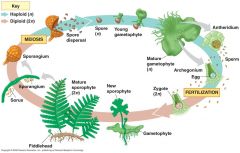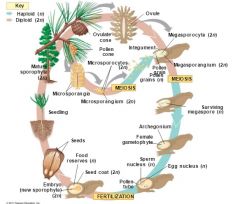![]()
![]()
![]()
Use LEFT and RIGHT arrow keys to navigate between flashcards;
Use UP and DOWN arrow keys to flip the card;
H to show hint;
A reads text to speech;
34 Cards in this Set
- Front
- Back
|
Five shared derived traits of Charophytes and plants |
cellulose synthesizing complexes peroxisome enzymes flagellated sperm formation of a pharmoblast molecular similarities |
|
|
sporopollenin |
a durable polymer that prevents an exposed zygote from drying out |
|
|
adaptive advantages and characteristics that lead to multicellularity
|
an increase in size coordinated patterns of growth specialized cells cell to cell communication hormones oogamous sexual reproduction |
|
|
isogamy |
2 mobile gametes of the same size |
|
|
anisogamy |
large egg and small sperm that are both mobile |
|
|
apical meristems alteration of generations walled spores produced by a sporangium multicellular gametangia multicellular and dependent embryos |
Five traits that Plantae has but charophycean lacks |
|
|
non-vascular flagellated sperm no true roots or tissues have hydroids for moving water and nutrients |
traits of bryophytes |
|
|
sporophylls |
spore producing leaves |
|
|
xylem |
moves water typically in one direction from root to shoot |
|
|
phloem |
moves photosynthesis products down from the leaves
|
|
|
lignin |
an organic polymer in vascular plants and some algae cell walls that produce rigidity and prevent rot |
|
|
cause of carboniferous period |
CO2 was pulled out of the atmosphere by the vast growth of trees which caused the air to cool and dry out causing glacier formation |
|
|
asexual reproduction |
creation of offspring without the fusion of sperm and egg |
|
|
sexual reproduction |
creation of offspring by fusion of a male and female gamete |
|
|
budding reproduction |
another individual "buds" off of another and either detached like in hydra or stays connected like in coral |
|
|
fission |
division of the parent into two or more individuals of about the same size |
|
|
fragmentation |
breaking off of a body part or parts and then that body part develops into another individual like in sea stars |
|
|
parthenogenisis |
development of a new individual from an unfertilized egg like in bees |
|
|
two fold cost of sexual reproduction |
sexual females produce less daughters than the females that are a sexual |
|
|
meiosis cost of sexual reproduction |
meiosis only allows half of an individuals genetic into to be passed down |
|
|
seedless vascular plant life cycle |

|
|
|
life cycle of bryophytes |

|
|
|
seed plant reproduction |

|
|
|
reduced gametophytes separation of male and female function ovules pollen grains seeds |
shared derived traits of seed plants |
|
|
high genetic variation facilitates adaptation speeds up evolution |
Advantages of Sexual Reproduction |
|
|
energy costly courtship uses time and resources sacrifices the fitness of one sex or the other |
Disadvantages of sexual reproduction |
|
|
saves energy courtship is not an issue greatest increase in fitness for each individual |
Advantages of asexual reproduction |
|
|
low energetic variability adaptation to environment is difficult retards evolution |
Disadvantages of asexual reproduction |
|
|
parthenogenesis |
offspring develops from an unfertilized egg |
|
|
hermaphroditism |
individuals that have both male and female reproductive systems |
|
|
sex reversal |
individuals that can change sexes |
|
|
the evolutionary advantage of sexual reversal |
always have more females for maximum reproduction |
|
|
external fertilization |
gametes are released into the environment where they fertilize |
|
|
internal fertilization |
sperm is deposited near the female reproduction tract creating a greater efficiency of conception in dry environments |

